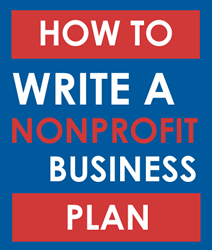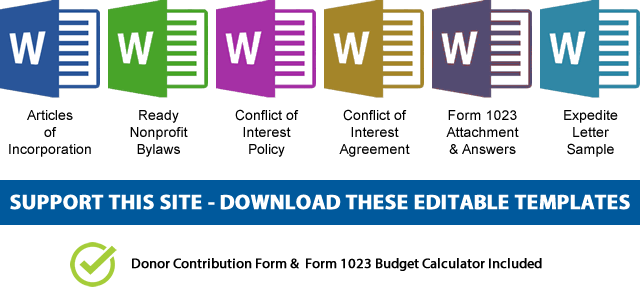The Crucial Role of Nonprofit Business Plan
 A nonprofit business plan serves as the compass guiding an organization toward its goals and mission-driven impact. When starting a nonprofit organization, you should write a business plan for your own sake if nothing else. Once you have your ideas on paper, you can decide whether you you should even peruse tax-exemption or not.
A nonprofit business plan serves as the compass guiding an organization toward its goals and mission-driven impact. When starting a nonprofit organization, you should write a business plan for your own sake if nothing else. Once you have your ideas on paper, you can decide whether you you should even peruse tax-exemption or not.
Nonprofit business plan is not just a document; it’s a road-map that aligns aspirations with practical strategies. Crafting a comprehensive plan helps articulate the organization’s purpose, outlining its objectives, methods, and the means to achieve them. It provides a structured framework for fundraising efforts, allowing nonprofits to effectively communicate their vision to potential donors, supporters, and stakeholders.
A well-thought-out nonprofit business plan also aids in demonstrating accountability and sustainability, crucial factors in garnering trust and support from the community and partners. It acts as a blueprint for growth, enabling flexibility to adapt to changing landscapes while staying true to the organization’s core values. Ultimately, a robust nonprofit business plan isn’t just about securing resources; it’s about fostering long-term viability and maximizing the positive impact on the communities and causes they serve.
The following are key subjects you should cover:
Executive Summary
[Insert name of nonprofit] is a nonprofit organization dedicated to [insert mission statement]. Our goal is to [insert key objectives]. We believe that our work will make a significant impact in [insert target community or issue area]. To achieve our mission, we will rely on [insert key strategies].
Key Objectives
Our key objectives for the next [insert time period] are as follows:
- Objective 1: [Insert objective, such as increasing program participation or expanding our reach to new communities]
- Objective 2: [Insert objective, such as securing additional funding sources or improving organizational efficiency]
- Objective 3: [Insert objective, such as enhancing partnerships or increasing public awareness of our mission]
Mission and Vision
Our mission is to [insert mission statement]. We envision a world where [insert vision statement].
Services and Programs
We offer a range of services and programs to support our mission, including:
- Program 1: [Insert description of program, including target population, goals, and outcomes]
- Program 2: [Insert description of program, including target population, goals, and outcomes]
- Program 3: [Insert description of program, including target population, goals, and outcomes]
Key Strategies
To achieve our mission, we will rely on the following key strategies:
- Strategy 1: [Insert strategy, such as developing new partnerships or expanding existing programs]
- Strategy 2: [Insert strategy, such as implementing new fundraising campaigns or improving organizational efficiency]
- Strategy 3: [Insert strategy, such as increasing public awareness through social media or community events]
Marketing and Outreach
We will use a range of marketing and outreach strategies to reach our target audience, including:
- Social media: We will use social media platforms such as Facebook, Twitter, and Instagram to share our mission and engage with our supporters.
- Events: We will host events throughout the year to engage with our supporters and raise awareness of our programs and services.
- Partnerships: We will partner with other organizations to reach new audiences and expand our impact.
Financial Plan
Our financial plan for the next [insert time period] is as follows:
- Income: We will generate income from a range of sources, including grants, donations, and fundraising events.
- Expenses: Our expenses will include staff salaries, program costs, rent, and other operational expenses.
- Budget: We have developed a detailed budget for the next [insert time period] that aligns with our key objectives and strategies.
Board of Directors
Our board of directors is made up of [insert number] members who bring a range of expertise and experience to the organization. The board is responsible for overseeing the strategic direction of the organization and ensuring that we are fulfilling our mission and vision.
Nonprofit Organizational Structure
The organizational structure of our nonprofit includes [insert number] departments, including [insert department names] and [insert department names]. Each department is headed by a director who is responsible for overseeing the department’s operations and achieving its goals.
In addition, we have [insert number] staff members and [insert number] volunteers who support our programs and services. Our staff includes [insert job titles] and our volunteers contribute their time and skills in a variety of areas, including program delivery, fundraising, and outreach.
SWOT Analysis (Strength, Weakness, Opportunities, Threats)
As part of our strategic planning process, we conducted a SWOT analysis to assess our strengths, weaknesses, opportunities, and threats. Here are some highlights:
Strengths:
- Strong relationships with key partners and stakeholders
- Experienced and dedicated staff and volunteers
- Successful track record of achieving key objectives
Weaknesses:
- Limited financial resources
- Reliance on a small number of key donors
- Limited capacity to scale programs and services
Opportunities:
- Growing demand for our services in the community
- Potential for new partnerships and collaborations
- Emerging funding opportunities in our issue area
Threats:
- Economic uncertainty and potential funding cuts
- Competition from other organizations with similar missions
- External factors that may impact our target population or issue area
Risk Management Plan
To mitigate the risks identified in our SWOT analysis, we have developed a risk management plan that includes the following strategies:
- – Diversifying our funding sources to reduce reliance on a small number of key donors
- – Building stronger relationships with our partners and stakeholders to increase support and collaboration
- – Developing contingency plans to address potential economic uncertainty and funding cuts
Conclusion
[Insert name of nonprofit] is committed to [insert mission statement], and we believe that our work will make a significant impact in [insert target community or issue area]. With our new strategic plan and key objectives, we are poised to achieve our goals and take our impact to the next level. We look forward to working with our supporters and partners to make a positive difference in the world.
Now let’s write a sample nonprofit business plan
Here’s a short sample nonprofit business plan for a fictional nonprofit organization called “Community Builders”:
Executive Summary
Community Builders is a nonprofit organization dedicated to empowering individuals and fostering community development. Our mission is to create thriving communities where everyone has access to opportunities and resources for personal and collective growth. By implementing innovative programs and fostering collaborations, we aim to address social challenges and create a positive impact on society.
Key Objectives
Our key objectives for the next three years are as follows:
– Objective 1: Increase access to quality education and skill-building opportunities for underserved populations.
– Objective 2: Enhance community engagement and foster social cohesion through neighborhood initiatives and events.
– Objective 3: Strengthen partnerships with local businesses, organizations, and government agencies to maximize our impact and reach.
Mission and Vision
Our mission is to empower individuals and communities by providing them with the tools, resources, and support necessary for growth and development. We envision a future where all communities thrive, and every person has an equal opportunity to succeed and contribute to society.
Services and Programs
Community Builders offers a range of services and programs designed to address the needs of our target communities, including:
– Education Empowerment Program: Providing after-school tutoring, mentoring, and career guidance to underprivileged students.
– Community Engagement Initiatives: Organizing community clean-up events, workshops, and cultural celebrations to foster a sense of belonging and social connection.
– Entrepreneurship Development: Offering training, mentorship, and microfinance support to aspiring entrepreneurs, enabling them to start and grow sustainable businesses.
Key Strategies
To achieve our mission, we will rely on the following key strategies:
– Collaboration and Partnerships: Building strong partnerships with local schools, businesses, nonprofits, and government agencies to leverage resources and expertise.
– Fundraising and Grant Acquisition: Diversifying our funding sources through grant applications, corporate sponsorships, individual donations, and fundraising events.
– Volunteer Engagement: Mobilizing volunteers from the community and corporate sector to actively participate in our programs and initiatives.
Marketing and Outreach
We will utilize various marketing and outreach strategies to raise awareness and engage our target audience, including:
– Social Media Presence: Maintaining active profiles on platforms such as Facebook, Instagram, and Twitter to share success stories, promote upcoming events, and engage with supporters.
– Community Awareness Campaigns: Collaborating with local media outlets, community centers, and schools to disseminate information about our programs and services.
– Networking and Public Relations: Attending community events, conferences, and workshops to establish strategic partnerships and enhance our organization’s visibility.
Financial Plan
Our financial plan for the next three years is as follows:
– Income: Generating revenue from individual and corporate donations, grants, fundraising events, and sponsorships.
– Expenses: Allocated to program costs, staff salaries, administrative expenses, marketing efforts, and infrastructure development.
– Budget: Developing a detailed budget that aligns with our key objectives and ensures effective financial management.
Board of Directors
Community Builders is governed by a diverse and experienced Board of Directors. They bring a range of expertise in community development, education, business, and nonprofit management. The Board is responsible for providing strategic guidance, overseeing organizational operations, and ensuring alignment with our mission and values.
Conclusion
Community Builders is committed to empowering individuals and fostering community development. With our strategic plan and key objectives in place, we are well-positioned to make a significant impact on the communities we serve. By working collaboratively, engaging stakeholders, and utilizing innovative approaches, we aim to create lasting positive change. We look forward to partnering with supporters, volunteers, and community members to build a better future together.
 NOTE: If you’d like to receive the following organizing documents:
NOTE: If you’d like to receive the following organizing documents:- Nonprofit Articles of Incorporation,
- Nonprofit Bylaws,
- Nonprofit Conflict of Interest Policy,
- Conflict of Interest Policy Acknowledgment,
- Form 1023 Attachment with all the answers,
- Form 1023 Expedite Letter template,
- and Donor Contribution Form
in Microsoft Word Document format, please consider making a donation and you’ll get to download them immediately. Not only they're worth well over $1000 in value, they will save you weeks of copy pasting and formatting as they are ready to go templates which only need changing names and addresses.

